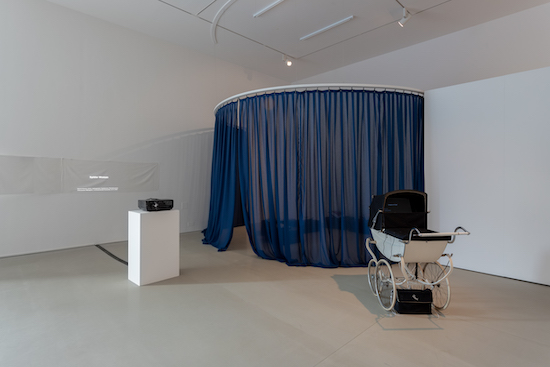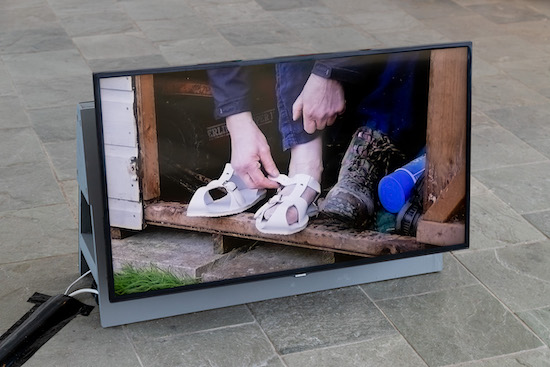Yuen Fong Ling installation image. All photos, credit: Jules Lister
The 2019 iteration of Sheffield’s Platform opened last week, highlighting the work of the five artists awarded residencies through Freelands Art Programme. A series of exhibitions, workshops and performances held across three of the city’s galleries, Platform showcases the breadth and diversity of Sheffield’s creative community as well as providing artists with an opportunity to test unfinished or developing ideas in a publicly accessible fashion.
The first of the three galleries, Bloc Projects, is showing a solo presentation from artist and academic Alison J. Carr. The show is comprised primarily of photography but includes several performances over the course of August as well as a film. Carr’s photographs come as part of an ongoing project following from research into the evolving ideologue of the showgirl. In this instance, it manifests as photographs of performance spaces, with each image showing contrasting aesthetics present in the modernisation undertaken by classically decorated theatres in the North of England.
My first impression of the work was a comparison to David Lynch’s aesthetic sensibilities, with ruffled velvet stage curtains, intersecting walkways, and ascending staircases rendered in vivid colour. The portray the spaces as almost dreamlike, creating highly textured, vivid images from the fibre of the carpet to the cobwebs in the rafters. But this happens without Lynch’s surreal sensibility. There is nothing uncanny about these pictures. On the contrary, they seem actively to move towards removing the magic from these spaces, exposing the fire exits, backstage areas and lighting rigs in direct aversion to the theatre’s necessity for suspended disbelief.
Carr’s work explores the complex duality of performance. Whilst the stage holds inherent power, as one becomes a spectacle there’s a notion of powerlessness, of becoming entertainment. In relation to her extensive research into the world of the showgirl, this highlights the relationship between the skilled execution of a prepared choreography and performing the object of desire for a given audience.
Part of what made this exhibition effective was the decision to address these themes subtly. They are present and visible but the viewer has space to draw on their personal experiences. It’s possible to disregard the notion of live performance entirely and think of the way these spaces are slowly being consumed by their need for maintenance. The macro photography – holding a more than passing resemblance to Rodney Graham’s lightboxes – is detailed to the point of revealing cobwebs on ceiling crossbeams. They explore the space romantically. They hint at nostalgia, even if only slightly, letting the viewer wander as they choose to.

Zoyander Street installation shot
In Yorkshire Artspace, there is another solo presentation from British-Chinese artist Yuen Fong Ling, inspired by research into Sheffield’s forefather of both LGBT and ecological activism, Edward Carpenter. Carpenter lived as an openly gay Christian spiritualist and environmentalist in Sheffield in the late 1800s. He and his partner George Merrill were the progenitors of a proud history for both LGBT activism and environmentalism in the city, with this exhibition existing partly as an archival response and partly as a monument to their achievements.
Entering the gallery, the immediate impression is of a pop-up shop. There’s a window display including sandals as well as an original photo of Carpenter, followed by a large wall graphic covering the full rear end of the gallery (part of an ongoing work Towards Memorial [2019]). Something that makes this work particularly effective is its use of humour, somewhere between a look book and the kind of ad display that wouldn’t go amiss in a Clark’s. The images show a pair of feet moving through the city in sandals until eventually, tentatively, meeting with a second pair of feet in a slightly more rural setting. The feet stand a short distance apart, timid, seemingly wanting to reach one another but without the confidence to do so immediately.
In the context of the show, we’re drawn to ideas around cruising and the chance encounter, intimate experiences in public space and the natural landscape. Interestingly, Carpenter met his lifelong partner (George Merrill, pictured throughout the exhibition) after being picked up by him on the platform of Totley Station in South Yorkshire. The couple remained together for the rest of their lives, eventually buried side by side in Guildford.
Carpenter famously preferred sandals to the style of shoes common at the time, alleging that to allow your feet to be physically closer to the earth was to be closer to nature. Ling worked with designers to produce a sandal inspired by Carpenter’s, eventually gifting the shoes to current activists in the city in the hope they would wear them in memorial as they continue to campaign for change across South Yorkshire. Shown on three screens set in the centre of the gallery, a series of films demonstrate the journey of the sandal, from a research project, through manufacture and eventual presentation as gifts. This aspect of the showing was particularly effective in allowing a complex narrative history to be communicated to an audience who would likely have no prior knowledge of Carpenter and his work.
Exhibiting at the final gallery, Site, are three artists: Zoyander Street, Lucy Vann, and Siân Williams. This selection is the one which most illustrates the aims of the Freelands Artist Programme and the stage the artists are currently at within it. The works are in progress and this is an opportunity for them to be exhibited while still developing. Although perhaps less resolved than the solo presentations, the exhibition at site demonstrates a progressive and socially engaged focus in Sheffield’s contemporary art community as well as the role public institutions are taking in supporting it.
The lasting impression from Platform is one of a city and its public institutions supporting contemporary art as a means of social progress. Carr’s work presents an interesting duality within the evolving aesthetic of performance spaces as well as our relationship to performers and what it means to be a performer. The same social progress is present in Ling’s extensive research and re-interpretation of Edward Carpenter’s activism, whose unique life and work is thoughtfully condensed – following in his footsteps by raising awareness. Across Site, the artists take this thread of progressive social attitudes and distil it to a personal, physical engagement concerned more directly with activity and labour. Platform is an example of a prevailing motivation of contemporary artists working in the North of England – the provision of accessible exhibitions which prioritise a demystification of social histories and lived experiences.
Platform 2019 is at Site Gallery, Bloc Projects and Yorkshire Artspace until 1 September


